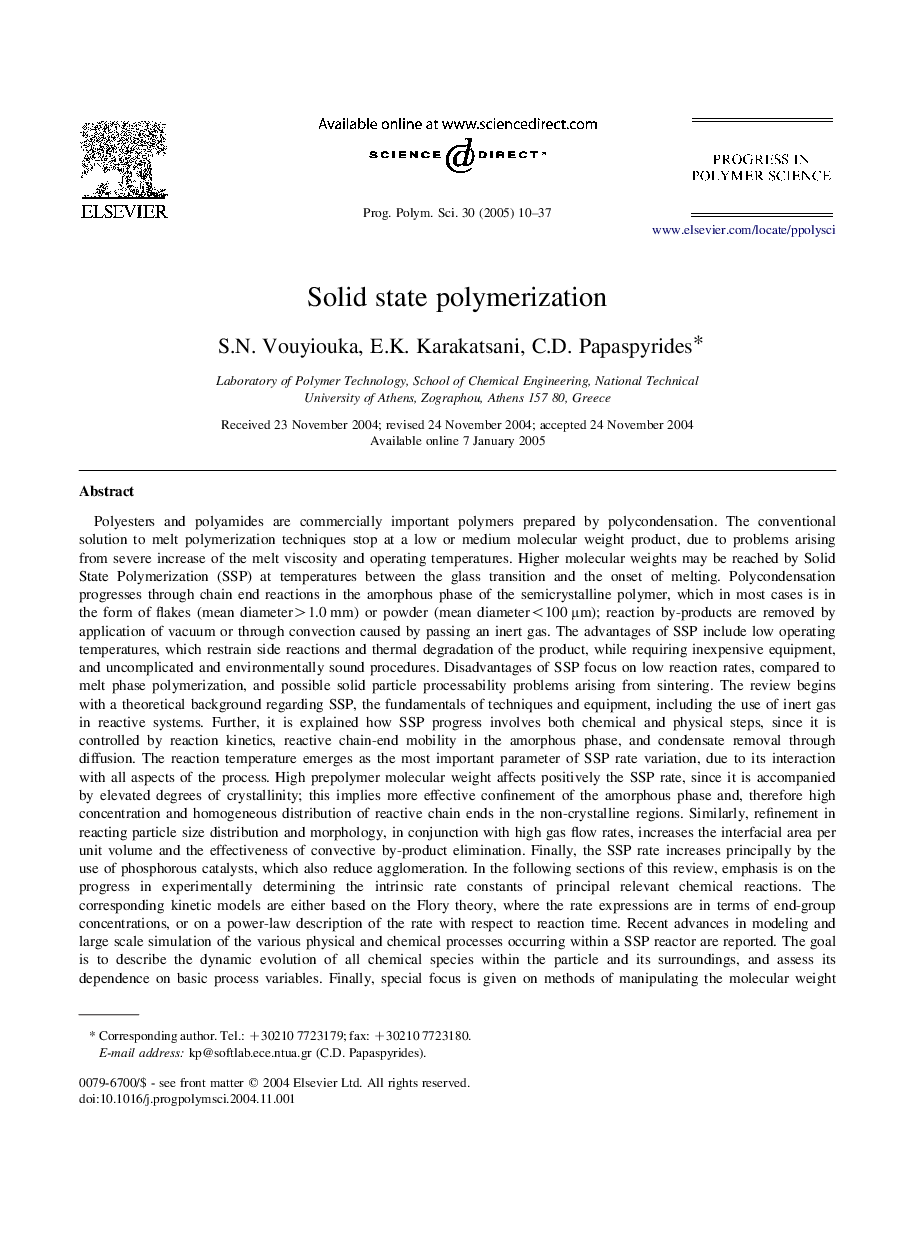| کد مقاله | کد نشریه | سال انتشار | مقاله انگلیسی | نسخه تمام متن |
|---|---|---|---|---|
| 9562420 | 1382669 | 2005 | 28 صفحه PDF | دانلود رایگان |
عنوان انگلیسی مقاله ISI
Solid state polymerization
دانلود مقاله + سفارش ترجمه
دانلود مقاله ISI انگلیسی
رایگان برای ایرانیان
کلمات کلیدی
موضوعات مرتبط
مهندسی و علوم پایه
شیمی
شیمی آلی
پیش نمایش صفحه اول مقاله

چکیده انگلیسی
Polyesters and polyamides are commercially important polymers prepared by polycondensation. The conventional solution to melt polymerization techniques stop at a low or medium molecular weight product, due to problems arising from severe increase of the melt viscosity and operating temperatures. Higher molecular weights may be reached by Solid State Polymerization (SSP) at temperatures between the glass transition and the onset of melting. Polycondensation progresses through chain end reactions in the amorphous phase of the semicrystalline polymer, which in most cases is in the form of flakes (mean diameter>1.0 mm) or powder (mean diameter<100 μm); reaction by-products are removed by application of vacuum or through convection caused by passing an inert gas. The advantages of SSP include low operating temperatures, which restrain side reactions and thermal degradation of the product, while requiring inexpensive equipment, and uncomplicated and environmentally sound procedures. Disadvantages of SSP focus on low reaction rates, compared to melt phase polymerization, and possible solid particle processability problems arising from sintering. The review begins with a theoretical background regarding SSP, the fundamentals of techniques and equipment, including the use of inert gas in reactive systems. Further, it is explained how SSP progress involves both chemical and physical steps, since it is controlled by reaction kinetics, reactive chain-end mobility in the amorphous phase, and condensate removal through diffusion. The reaction temperature emerges as the most important parameter of SSP rate variation, due to its interaction with all aspects of the process. High prepolymer molecular weight affects positively the SSP rate, since it is accompanied by elevated degrees of crystallinity; this implies more effective confinement of the amorphous phase and, therefore high concentration and homogeneous distribution of reactive chain ends in the non-crystalline regions. Similarly, refinement in reacting particle size distribution and morphology, in conjunction with high gas flow rates, increases the interfacial area per unit volume and the effectiveness of convective by-product elimination. Finally, the SSP rate increases principally by the use of phosphorous catalysts, which also reduce agglomeration. In the following sections of this review, emphasis is on the progress in experimentally determining the intrinsic rate constants of principal relevant chemical reactions. The corresponding kinetic models are either based on the Flory theory, where the rate expressions are in terms of end-group concentrations, or on a power-law description of the rate with respect to reaction time. Recent advances in modeling and large scale simulation of the various physical and chemical processes occurring within a SSP reactor are reported. The goal is to describe the dynamic evolution of all chemical species within the particle and its surroundings, and assess its dependence on basic process variables. Finally, special focus is given on methods of manipulating the molecular weight distribution of the SSP product, by varying prepolymer particle size distribution, initial stoichiometry and condensate content in the surroundings.
ناشر
Database: Elsevier - ScienceDirect (ساینس دایرکت)
Journal: Progress in Polymer Science - Volume 30, Issue 1, January 2005, Pages 10-37
Journal: Progress in Polymer Science - Volume 30, Issue 1, January 2005, Pages 10-37
نویسندگان
S.N. Vouyiouka, E.K. Karakatsani, C.D. Papaspyrides,